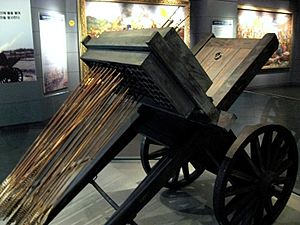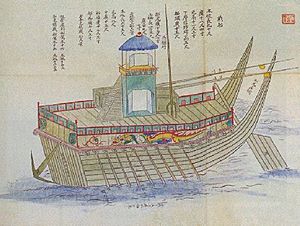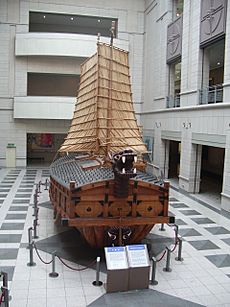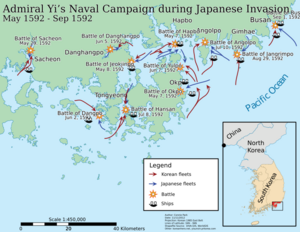Japanese invasions of Korea (1592–1598) facts for kids
Quick facts for kids Japanese invasions of Korea |
|||||||
|---|---|---|---|---|---|---|---|
 The Japanese landing at Pusan |
|||||||
|
|||||||
| Belligerents | |||||||
| Commanders and leaders | |||||||
|
Joseon Military commanders Gwak Jae-u Ming |
Toyotomi regime
|
||||||
| Strength | |||||||
|
Joseon: 50,000 soldiers Total: 100,000 Ming 192,000 Joseon |
Japan Total: ~300,000 |
||||||
| Casualties and losses | |||||||
|
Joseon: 1,000,000+ civilian and military deaths Ming: ~20,000 killed |
Japan: 100,000+ soldiers killed 450 ships |
||||||
| Japanese invasions of Korea | |||||||||||
|---|---|---|---|---|---|---|---|---|---|---|---|
| Chinese name | |||||||||||
| Traditional Chinese | 萬曆朝鮮之役 | ||||||||||
| Simplified Chinese | 万历朝鲜之役 | ||||||||||
|
|||||||||||
| North Korean name | |||||||||||
| Chosŏn'gŭl | 임진조국전쟁 | ||||||||||
| Hancha | 壬辰祖國戰爭 | ||||||||||
|
|||||||||||
| South Korean name | |||||||||||
| Hangul | 임진왜란·정유재란 | ||||||||||
| Hanja | 壬辰倭亂·丁酉再亂 | ||||||||||
|
|||||||||||
| Japanese name | |||||||||||
| Kanji | 文禄の役 (1592–1593) 慶長の役 (1597–1598) |
||||||||||
| Hiragana | ぶんろくのえき けいちょうのえき |
||||||||||
|
|||||||||||
The Japanese invasions of Korea, also known as the Imjin War, were two big attacks by Japan on Korea. The first invasion happened in 1592, followed by a short break in 1596. Then, a second invasion took place in 1597. The war ended in 1598 when Japanese forces left Korea. This happened after a long fight where neither side could win completely.
These invasions were started by Toyotomi Hideyoshi, a powerful leader in Japan. He wanted to conquer Korea and then China proper, which were ruled by the Joseon and Ming dynasties. At first, Japan quickly took over large parts of Korea. But then, China sent help to Korea. Also, the Korean navy stopped Japanese supply ships along the coast. This forced the Japanese to pull back from northern Korea.
After that, Korean civilian armies, called "righteous armies", fought against the Japanese. They used guerrilla warfare tactics. Both sides had trouble getting supplies. This led to a long period where neither side could make much progress. The first part of the war ended in 1596. Japan and China tried to make peace, but it didn't work.
In 1597, Japan attacked Korea a second time. This invasion was similar to the first. Japan had early success on land, capturing several cities. But again, the Ming forces and the Korean navy stopped them. The Japanese had to retreat to the southern coast. However, the Korean and Ming armies couldn't push them out of these areas. This led to another long fight that lasted ten months.
When Toyotomi Hideyoshi died in 1598, the new Japanese leaders ordered their forces to leave Korea. This was because they weren't making much progress on land and the Korean navy kept cutting off their supplies. After the war, Japan, Korea, and China had peace talks for several years. These talks eventually helped them become friends again. The Japanese invasions of Korea were the biggest sea attacks in history at that time. Japan sent over 300,000 soldiers to fight.
Contents
Understanding the War's Names
In Korean, the first invasion (1592–1593) is called the "Japanese Disturbance of Imjin." The year 1592 was an imjin year in the old calendar. The second invasion (1597–1598) is called the "Second War of Jeong-yu." Together, they are known as the "Imjin War."
In Chinese, the wars are called the "Wanli Korean Campaign." This is named after the Chinese emperor at the time.
In Japanese, the first part of the war is called Bunroku no eki, and the second part is Keichō no eki. These names come from Japanese time periods.
Why Did the War Start?
Before the war, Korea and China had a close relationship. Korea was a "tributary state" of China. This meant Korea respected China as a "big brother" and traded with them. Japan had also been part of this system but chose to leave it. This stopped their trade with China.
Japan's Leader and His Big Plans
By the late 1500s, Toyotomi Hideyoshi had united all of Japan. He was a very powerful leader, but he wasn't from a royal family. He wanted to show his power and keep his soldiers busy. So, he planned to invade Korea and then China. He also thought this would stop his own generals from fighting each other.
Hideyoshi believed that Japan should be the most important country in East Asia, like China had been for a long time. He also thought Korea and China were weak because Japanese pirates had raided them before.
Diplomatic Dealings Before the War
Hideyoshi tried to get Korea to join him in attacking China. In 1587, he sent a messenger to Korea. But the Korean court saw Japan as less important and refused. They were proud of their strong ties with China.
In 1590, Korean ambassadors visited Japan. Hideyoshi thought they were coming to show respect to Japan. He asked Korea to join his war against China. But Korea refused again, saying no to Hideyoshi's challenge to China's power. After these talks failed, Hideyoshi decided to invade Korea in 1592.
The war involved three main forces: Japan, Korea (Joseon), and China (Ming dynasty). Each had different strengths and weaknesses.
Japan's Strong Army

Japan's army was made up of samurai (skilled warriors) and ashigaru (light infantry, often peasants). Samurai were the main fighters, using spears and swords like the famous katana. They wore special armor and masks to scare enemies.
Japanese soldiers were very experienced from many years of civil war in Japan. They were especially good with arquebuses, which were early firearms. They used these guns in formations, firing in turns to create a constant stream of bullets. This gave them a big advantage on land.
About 158,800 Japanese soldiers and support staff were ready for the first invasion. They had many transport ships and warships.
China's Large Army

China had the largest army in Asia. Their soldiers used crossbows, arquebuses, and spears. Chinese cavalry often used bows while riding horses. Chinese artillery (cannons) was considered the best in the region. They had powerful cannons that could fire far.
China sent about 40,000 soldiers in the first phase and later more, totaling around 100,000 troops. They also sent a lot of money and supplies to Korea.
Korea's Developing Military
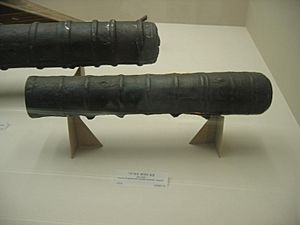
Korean officers were usually scholars, not career soldiers. This meant some were not as experienced in war as the Japanese. Korean foot soldiers wore helmets but little armor. They used a curved sword called the hwando and were known for their archery skills. Their bows could shoot farther than Japanese bows.
Korea also had a unique weapon called the hwacha. This was a cart that could fire up to 200 rocket-powered arrows at once, causing great damage.
Korea's navy was its biggest strength. They had advanced ships called panokseon and the famous "turtle ships" (geobukseon). These ships were strong, armed with heavy cannons, and could outrange most Japanese vessels. Japanese ships were often modified merchant vessels, not built for heavy cannons.
The turtle ships were especially tough. They had a roof covered in iron spikes to stop enemies from boarding. They could fire cannons from all sides, including a dragon's head at the front. These ships were fast and hard to sink.
Admiral Yi Sun-sin was the brilliant commander of the Korean navy. He is considered one of the greatest naval commanders in history. His strategies helped protect Korea's coasts and cut off Japanese supplies.
The First Invasion (1592–1593)
Japan's first attack began on May 23, 1592.
Japanese Landings and Early Victories
The Japanese First Division, led by Konishi Yukinaga, landed at Busan. They quickly captured Busan and the nearby Dongnae Fortress. The Japanese were very brutal, killing almost everyone in these cities to scare the Koreans. But this only made Koreans more determined to fight back.
Japanese forces moved quickly inland. They captured Korea's capital, Hanseong, in just three months. King Seonjo and the Korean court had to flee north. The Japanese army, with their powerful arquebuses and battle experience, won many early battles on land.
Korean Resistance and Chinese Help
As the Japanese advanced, Koreans started to fight back. Civilian groups, called "righteous armies", formed to resist the invaders. They used guerrilla warfare tactics, attacking Japanese supply lines and small groups of soldiers. Buddhist monks also joined the fight, forming "warrior monk" units.
Meanwhile, King Seonjo asked China for help. The Wanli Emperor of China saw the Japanese invasion as a threat to his own country. China sent a large army under General Li Rusong to help Korea.
Key Battles on Land
- Siege of Pyongyang (1593): The combined Chinese and Korean forces attacked the Japanese-held city of Pyongyang. After fierce fighting, using cannons and fire arrows, they forced the Japanese to retreat. This was a major victory for the allies.
- Battle of Byeokjegwan: After retaking Pyongyang, the Ming army advanced towards Hanseong. They met a large Japanese force at Byeokjegwan. The battle was very intense, with heavy losses on both sides. The Ming forces eventually retreated, showing the strength of the Japanese army.
- Battle of Haengju: Korean forces under General Gwon Yul defended Haengju Fortress against a large Japanese attack. They used hwachas (rocket launchers) and other weapons to inflict heavy losses on the Japanese. The Koreans won this battle, boosting their morale.
While the Japanese were strong on land, the Korean navy, led by Admiral Yi Sun-sin, was dominant at sea.
- Battle of Okpo: Yi Sun-sin's fleet surprised and destroyed 26 Japanese ships without losing any of his own. This was the first major Korean naval victory.
- Battle of Sacheon: Yi Sun-sin used his new turtle ship for the first time. It was heavily armored and armed. His fleet destroyed 12 Japanese ships.
- Battle of Hansan Island: This was a huge victory for Yi Sun-sin. He used a "crane wing" formation to trap and destroy 59 Japanese ships. This defeat made Japan stop all major naval operations for a while.
- Battle of Busan (1592): The Korean navy attacked the main Japanese fleet at Busan. They destroyed many Japanese ships, but couldn't take the port itself.
These naval victories were crucial. They cut off Japanese supply lines, making it hard for them to get food, weapons, and new soldiers. This greatly weakened the Japanese army on land.
The First Siege of Jinju
Jinju was an important fortress. The Japanese wanted to capture it to get to the rich lands of Jeolla Province. In the first siege, Korean defenders, led by Gim Si-min, used cannons and arquebuses to fight off repeated Japanese attacks. Korean civilian fighters also helped. The Japanese suffered heavy losses and had to retreat. This victory prevented the Japanese from entering Jeolla Province.
Stalemate and Peace Talks
After many battles, the war reached a stalemate. The Japanese were stuck in the south, struggling with supplies. The Chinese and Korean forces also faced challenges with logistics. Both sides were tired of fighting.
Peace talks began between China and Japan. However, the two sides had very different ideas about peace. Japan's leader, Hideyoshi, thought China would accept him as an emperor. China thought Japan was surrendering. Because of these misunderstandings, the peace talks failed.
The Second Invasion (1597–1598)
After the peace talks failed, Hideyoshi launched a second invasion in 1597. This time, Japan's main goal was to conquer Korea, not China.
Before the second invasion, King Seonjo wrongly jailed Admiral Yi Sun-sin. He was replaced by Won Gyun. In the Battle of Chilcheollyang, Won Gyun led the Korean navy into a trap. Almost the entire Korean fleet was destroyed. Only 13 ships survived, saved by another officer. This was Japan's only major naval victory of the war.
After this disaster, King Seonjo quickly put Yi Sun-sin back in charge. Yi Sun-sin had only 13 ships, but he faced a huge Japanese fleet of over 130 warships. In the Battle of Myeongnyang, Yi Sun-sin used a narrow strait to his advantage. He trapped the Japanese fleet and destroyed about 30 of their ships without losing any of his own. This incredible victory saved Korea's navy and stopped the Japanese from moving their forces by sea.
Land Battles in the Second Invasion
- Siege of Namwon: After the naval disaster, Japanese forces pushed into Jeolla Province. They besieged Namwon, which was defended by Korean and Chinese troops. The Japanese captured the fortress, killing most of the defenders.
- Battle of Jiksan: Chinese and Korean forces stopped a Japanese advance towards Hanseong at Jiksan. This battle prevented the Japanese from reaching the capital again.
- Siege of Ulsan: The allies tried to capture the Japanese-held fortress at Ulsan. They almost succeeded, but Japanese reinforcements arrived, and the allies had to retreat with heavy losses.
Hideyoshi's Death and Japanese Withdrawal
The war continued with more fighting, but neither side could gain a decisive advantage. In September 1598, Toyotomi Hideyoshi died in Japan. The new Japanese leaders decided to pull all their forces out of Korea. They kept Hideyoshi's death a secret to maintain morale.
The Final Battle: Noryang
The Battle of Noryang was the last major naval battle of the war. A large Japanese fleet tried to meet up with other Japanese forces to escape Korea. The Korean navy, led by Yi Sun-sin, and a Chinese fleet, led by Chen Lin, attacked the Japanese in the narrow Noryang Strait.
The allies used cannons and fire arrows in a surprise night attack. They destroyed more than half of the Japanese fleet. During the battle, both Admiral Yi Sun-sin and Chinese General Deng Zilong were killed. Despite these losses, the battle was a huge victory for the allies. It allowed most Japanese forces to withdraw safely, but at a great cost to their navy. The war officially ended on December 24, 1598, when the last Japanese ships left Korea.
What Happened After the War?
The war had a huge impact on all three countries.
Losses and Changes
- Japan: The war greatly weakened the power of Hideyoshi's family. This helped Tokugawa Ieyasu rise to power and become the new ruler of Japan.
- China: The war was very expensive for China. It also weakened China's position in the north, allowing a new group, the Manchu people, to grow stronger. They would later conquer China.
- Korea: Korea suffered the most. Much of its land was destroyed, and many people died. Famine and disease were common. Important historical sites and cultural treasures were lost or damaged. Many skilled Korean craftsmen and scholars were taken to Japan, which helped Japan develop its own arts and technology.
Despite the destruction, the war also brought some changes. Korea quickly adopted Japanese firearms, which improved its military. Catholicism was also introduced to Korea by missionaries who came with the Japanese.
War's Impact on People
The war was very hard on civilians. Soldiers from all sides sometimes took food and supplies from people. Japanese soldiers were known to be very harsh, often killing people and taking women captive. Korean and Chinese soldiers also sometimes treated civilians badly.
The War's Legacy
The Imjin War left a lasting mark on East Asia.
- In Japan, some later leaders used the invasions to justify their plans to control Korea in the 20th century.
- In China, the war is seen as an example of China's willingness to protect its allies.
- In Korea, the war became a symbol of national pride and resistance. Heroes like Yi Sun-sin are still celebrated today. The war also contributed to strong feelings against Japan in Korea.
Images for kids
-
Daimyo Katō Kiyomasa commanded the Japanese Second Division
-
Katō Kiyomasa's (1562–1611) banner and battle standard
-
Japanese arquebuses used during the invasions.
-
Ming-era matchlock firearms.
-
The Wanli Emperor of the Ming dynasty.
-
Painting of the Ming army camped in Ningxia.
-
A naval battle. Close combat was very rare during Admiral Yi Sun-sin's operations.
-
Yeosu in 2005. Admiral Yi Sun-sin's headquarters were located here.
-
Yi Sun-sin's crane wing formation, famously used at the Battle of Hansando.
See also
 In Spanish: Invasiones japonesas de Corea (1592-1598) para niños
In Spanish: Invasiones japonesas de Corea (1592-1598) para niños


